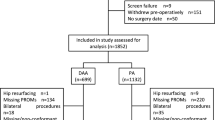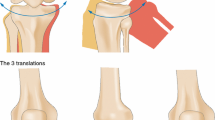Abstract
Purpose
The aim of this study was to confirm the alleviating effects of the nontourniquet technique on the postoperative acute and chronic pain of patients after total knee arthroplasty (TKA).
Methods
122 elderly patients undergoing TKA were randomly divided into two groups: group T (n = 58) and group H (n = 64). An electronic inflatable tourniquet was used during TKA in group T. The patients in group H received controlled hypotension but without tourniquet use during the operation. The numeric rating scale (NRS) score was used to evaluate pain level on day 1, day 2, day 3 and day 7 after the operation, and the incidence of chronic pain was judged at 3-month and 1-year follow-ups, and functional recovery of the knee joint was estimated by the active range of knee joint motion (AROM) at the same time points. Cognitive function was assessed by the montreal cognitive assessment scale (MoCA) for 7 days after operation.
Results
There were no significant differences in the NRS scores and AROM for 7 days after surgery. The incidence rate of chronic pain in group H (25.0%) was lower than that in group T (41.4%) and the AROM in group H was greater at one year follow-up. The MoCA score in group H was lower than that in group T on day 1 and day 2.
Conclusion
The nontourniquet combined with controlled hypotension technique can alleviate chronic pain and promote the long-term rehabilitation of patients after TKA.


Similar content being viewed by others
References
Rama KR, Apsingi S, Poovali S, Jetti A. Timing of tourniquet release in knee arthroplasty. Meta-analysis of randomized, controlled trials. J Bone Jt Surg Am. 2007;89(4):699–705.
Prasad N, Padmanabhan V, Mullaji A. Blood loss in total knee arthroplasty:an analysis of risk factors. Int Orthop. 2007;31(1):39–44.
Zhang W, Li N, Chen S, Tan Y, Al-Aidaros M, Chen L. The effects of a tourniquet used in total knee arthroplasty: a meta-analysis. J Orthop Surg Res. 2014;9(1):13.
Tai WT, Lin CJ, Jou IM, Chang CW, Lai KA, Yang CY. Tourniquet use in total knee arthroplasty: a meta-analysis. Knee Surg Sports Traumatol Arthrosc. 2011;19(7):1121–30.
Li Z, Liu D, Long G, Ke G, Xia A, Tang P, Dong J. Association of tourniquet utilization with blood loss, rehabilitation, and complications in Chinese obese patients undergoing total knee arthroplasty. Medicine (Baltimore). 2017;96(49):e9030.
Liu D, Graham D, Gillies K, Gillies RM. Effects of tourniquet use on quadriceps function and pain in total knee arthroplasty. Knee Surg Relat Res. 2014;26(4):207–13.
Wang K, Ni S, Li Z, Zhong Q, Li R, Li H, Ke Y, Lin J. The effects of tourniquet use in total knee arthroplasty: a randomized, controlled trial. Knee Surg Sports Traumatol Arthrosc. 2017;25(9):2849–57.
Huang H, Tanner J, Parvataneni H, Rice M, Horgas A, Ding M, Price C. Impact of total knee arthroplasty with general anesthesia on brain networks: cognitive efficiency and ventricular volume predict functional connectivity decline in older adults. J Alzheimers Dis. 2018;62(1):319–33.
Wong A, Nyenhuis D, Black SE, Law LS, Lo ES, Kwan PW, Au L, Chan AY, Wong LK, Nasreddine Z, Mok V. Montreal cognitive assessment 5-minute protocol is a brief, valid, reliable and feasible cognitive screen for telephone administration. Stroke. 2015;46(4):1059–64.
Zhang Y, Li L, Wang J, Li ZH, Shi ZJ. Do patients benefit from tourniquet in arthroscopic surgeries of the knee? Knee Surg Sports Traumatol Arthrosc. 2013;21(5):1125–30.
Harbell MW, Cohen JM, Kolodzie K, Behrends M, Braehler MR, Kinjo S, Feeley BT, Aleshi P. Combined preoperative femoral and sciatic nerve blockade improves analgesia after anterior cruciate ligament reconstruction: a randomized controlled clinical trial. J Clin Anesth. 2016;33:68–74.
Skinner HB, Shintani EY. Results of a multimodal analgesic trial involving patients with total hiportotal knee arthroplasty. Am J Orthop (Belle Mead NJ). 2004;33(2):85–92.
Tomita M, Motokawa S. Effects of air tourniquet on the antibiotics concentration, in bone marrow, injected just before the start of operation. Mod Rheumatol. 2007;5(1):409–12.
Barker T, Rogers VE, Brown KB, Henriksen VT, Rasmussen GL. Tourniquet use during total knee arthroplasty does not modulate the neutrophil-to-lymphocyte ratio, pain, or activity. J Orthop Traumatol. 2017;18(3):283–7.
Sugiyama Y, Iida H, Amaya F, Matsuo K, Matsuoka Y, Kojima K, Matsuno F, Hamaguchi T, Iseki M, Yamaguchi K, Takahashi Y, Hara A, Sugasawa Y, Kawamata M, Tanaka S, Inagaki Y, Otsuki A, Yamazaki M, Ito H. Prevalence of chronic postsurgical pain after thoracotomy and total knee arthroplasty: a retrospective multicenter study in Japan (Japanese Study Group of Subacute Postoperative Pain). J Anesth. 2018;32(3):434–8.
Muyskens JB, Hocker AD, Turnbull DW, Shah SN, Lantz BA, Jewett BA, Dreyer HC. Transcriptional profiling and muscle cross-section analysis reveal signs of ischemia reperfusion injury following total knee arthroplasty with tourniquet. Physiol Rep. 2016;4(1):e12671.
Memtsoudis SG, Valle AG, Jules-Elysse K, Poultsides L, Reid S, Starcher B, Ma Y, Sculco TP. Perioperative inflammatory response in total knee arthroplasty patients: impact of limb preconditioning. Reg Anesth Pain Med. 2010;35:412–6.
Windisch C, Brodt S, Roehner E, Matziolis G. The C-reactive protein level after total knee arthroplasty is gender specific. Knee Surg Sports Traumatol Arthrosc. 2016;24(10):3163–7.
Huang CC, Yang CH, Hsu KS. Do stress and long-term potentiation share the same molecular mechanisms. Mol Neurobiol. 2005;32(3):223–35.
Deng LQ, Hou LN, Song FX, Zhu HY, Zhao HY, Chen G, Li JJ. Effect of pre-emptive analgesia by continuous femoral nerve block on early postoperative cognitive function following total knee arthroplasty in elderly patients. Exp Ther Med. 2017;13(4):1592–7.
Goto T, Maekawa K. Cerebral dysfunction after coronary artery bypass surgery. J Anesth. 2014;28(2):242–8.
Öztürk S, Saçar M, Baltalarlı A, Öztürk İ. Effect of the type of cardiopulmonary bypass pump flow on postoperative cognitive function in patients undergoing isolated coronary artery surgery. Anatol J Cardiol. 2016;16(11):875–80.
Author information
Authors and Affiliations
Corresponding author
Additional information
Publisher's Note
Springer Nature remains neutral with regard to jurisdictional claims in published maps and institutional affiliations.
About this article
Cite this article
Dong, J., Min, S., He, KH. et al. Effects of the nontourniquet combined with controlled hypotension technique on pain and long-term prognosis in elderly patients after total knee arthroplasty: a randomized controlled study. J Anesth 33, 587–593 (2019). https://doi.org/10.1007/s00540-019-02671-z
Received:
Accepted:
Published:
Issue Date:
DOI: https://doi.org/10.1007/s00540-019-02671-z




